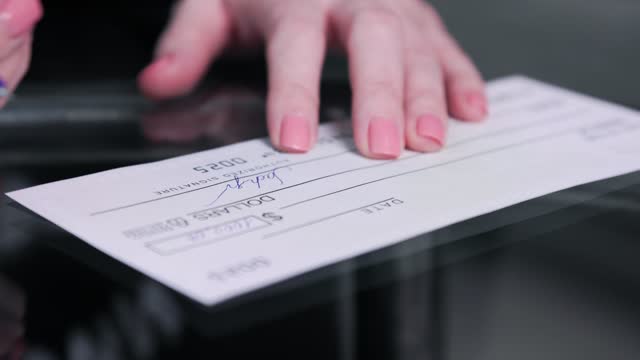Money orders are almost as easy to fill out as a personal check. Different channels use different formats, but they all want the same core information. Most money orders are processed by one of three companies: Western Union, MoneyGram, or the United States Postal Service.
Here’s a step-by-step guide on when to use a money order, where to buy one, and how to fill it out correctly.
What is a money order?
A money order looks and works similar to a check, but you don’t need to have a bank account to use one. This is because you pay the face value of the money order when you buy it. You can buy one for a few dollars more than face value with cash or a credit or debit card.
When should you use a money order?
When you need to pay someone, or someone needs to pay you, and for some reason cash, a personal check, or a smartphone app isn’t a viable option, a money order may be the answer.
A money order is a piece of paper, but it’s more secure than cash because it’s addressed to a specific recipient who must confirm and identify themselves in order to redeem it. Money orders are useful for those who don’t have a bank account or don’t want to accept personal checks. Even if you use checks, you may not want to share the personal information printed on them with specific recipients, such as B. Your address and account number. Money orders are generally accepted because they are prepaid, eliminating the risk of a bad check.
Money orders are not as secure as certified and cashier’s checks issued by financial institutions. However, they have significantly higher fees and require a visit to a bank during business hours, whereas a money order is an easier and cheaper choice.
Where can you get a payment order to fill out?
Online money orders are still uncommon and expensive. So to buy a money order, you usually have to go to a store that sells it and leave with a paper money order in hand.
Fortunately, many locations across the United States sell money orders, many of which are open late and on weekends. You can get one at any Walmart, CVS, or 7-Eleven, as well as any of the 31,300 USPS retail locations. Money orders are also available from banks, credit unions, grocery chains, and check cashing services.
Money orders have a $1,000 limit, but you can order more than one at a time.
What is the cost of money orders?
Almost all purchases made by postal order are subject to a fee, so it’s a good idea to shop around. Most Walmart stores charge $1.00, but the USPS charges $1.30 to $1.75 depending on the amount. Prices are much higher in the international market. The USPS , for example, costs a minimum of $10.55 plus a surcharge.
Prices from banks, credit unions, and other merchants can be much higher. Some banks, on the other hand, make them available for free to certain types of consumers.
Credit card issuers typically charge exorbitant fees for money order purchases since they are treated as cash advances. There may also be interest charges, so avoid this alternative if at all possible.
What information is required to fill out a money order?
To fill out a money order, you first need to know the exact amount of money you need. This is automatically printed directly on the payment order and cannot be changed later. You must also have the full name of the person or company you are issuing the money order to. If you are not precise, the recipient may have trouble redeeming it.
When making payments to businesses, please include the account or invoice number to ensure the payment is properly credited to you. You can fill in this information later, but if it’s lost or stolen, a blank money order (as long as it says cash on it) is as good as cash.
If you’re not at your bank and can withdraw it from your account, bring a debit card or cash to pay for your money order.
Note: If you forget to put the recipient’s name on your money order and then lose it, anyone can redeem it; it is essentially found money.
General information
The procedures for filling out a money order differ depending on the organization, be it Western Union or the US Postal Service. The appearance of each institution’s payment order may also differ slightly. However, you will typically need the following information:
However, to properly fill out a money order, you must provide the following information:
1. Surname:
Include the full name of the person or business being paid with the money order. This field could be titled “Payment on behalf of”, “Payment to”, or “Payee”. If you leave this section blank or redeem the money order for cash, anyone can redeem it and you risk losing the money if the money order is lost or stolen. Some issuers also require the buyer’s name in the “From” field
2. Address:
Some money orders ask for your current mailing address in case the recipient needs to contact you about payment. If you are concerned about your privacy, you may be able to omit this information. Check with the paying agent issuer and recipient for requirements. USPS money orders have an address field on the left for the recipient’s address and another on the right for the buyer’s address, so both the recipient’s address and your address appear.
3. Information:
You may need to include additional information in the payment order in order for the payment to be processed properly. This may include your account number, transaction or order details, or other information that helps the recipient determine the reason for the payment. This field could be named “Re:” or “Memo”. If there is no space for it, write it on the front of the paper.
4. Signature:
Some money orders require a signature. On the front of the document, look for a field labeled “Signature,” “Buyer,” or “Artist.” Do not sign the documents back as this is where the recipient signs the money order.
Keep any receipts, carbon copies, and other documentation you receive after completing your money order in case there is a problem with your payment. These documents may be required to cancel the money order and can be useful when tracking or confirming a payment.
You will also need a form of payment (cash, check, debit card) to purchase the money order. Some issuers also restrict your payment options. For example, you most certainly will not be able to purchase a money order with a credit card.
Also read about ExamLabs
How to fill out a money order
Learning how to create a money order is easy, but getting it right is crucial. You can make sure your money is going to the right person or company by following these simple procedures.
1. Enter the name of the payee
The payee is the person or money that receives the money order. If you make a cash payment to a person, it can be a person. If you’re using the money order to pay a bill, it can be a business name.
The name of the payee or payee should be written in the box labeled “Pay to the Order of” or “Pay to” on your money order. If the money order is lost or stolen, write their name clearly and in ink so it can’t be changed later.
It’s important to fill out the payee section first, as anyone can enter their name on the money order and redeem it until this is done.
2. Enter the payee’s address
You should notice another payee address field below the payee name field. Enter the address of the recipient here.
You can provide the payee’s home address if it’s a person. If you’re using a money order to pay a business, enter the business address here.
Again, it is important to write this information correctly and in ink. Check that you have spelled the house number and name correctly.
3. Complete the buyer information fields on the money order
There are a handful of places where you enter your details as a buyer or person purchasing the money order.
First enter your name, depending on where you are buying it this area may be marked ‘From’ or ‘Buyer’ on the money order.
Then you write down your address. If this information is required, it will usually be placed under your name.
4. End the memo line
You may notice a “Memo” field somewhere on your money order. Here you write the purpose of the money order.
Let’s say you use a money order to buy a used car from a private seller. You could include a statement in the note line stating that this is the funds’ money.
If you pay an invoice, you can enter this in the note line. Also include the account number for the bill you are paying.
5. Sign the money order to complete it.
There should be a “Signature” field somewhere on the money order. After you fill out the rest of the money order, add your signature here.
This last step before shipping to the recipient is not required for USPS postal money orders.
On the back of the money order, you might notice a space for a signature, but it’s not for you. After receiving the payment order, the payee signs it here.
Tips for filling out a money order
- Always use a pen when filling out payment instructions.
- Check with the company you are sending the money order to how they would like the money order to be addressed.
- If you are carrying a large sum of money to purchase a money order, use extreme caution and discretion.
- A blank money order is equivalent to cash. Fill it out as soon as possible. You lose your money if it’s lost or stolen.
What to do after filling out a money order
After you’ve filled out all the required fields on the money order, go through it again to make sure all the information is correct. If you realize you’ve made a mistake, don’t try to fix it yourself.
Instead, show the inaccuracy to the person or company you are purchasing the money order from. They may be able to fix it for you depending on their rules. If you’ve already paid for the money order, you may need to cancel it and buy a new one.
If you haven’t already paid for your money order, you must do so before you can send it. To pay for money orders, you usually need cash or a debit card. However, certain payment service providers accept credit card payments.
Aside from the face value of the money order, you must also pay any fees charged by the issuer, which can range from less than $1 to $5 depending on where you acquire the money order.
Keep your receipt after paying. This receipt should include a tracking number that you can use to track the money order and determine when it was redeemed.
Your receipt is also useful if you later need to cancel or replace a money order because it’s lost or stolen. If a money order is lost and you don’t have the original receipt, it can be difficult to get your money back.
How to send a money order
When you have filled out all the fields, make sure to remove the receipt. This stub contains the money order’s legal identification number and can be used to track whether or not the money order has been redeemed. It also serves as a receipt for your payment.
You can securely hand or mail the money order to your recipient now that you have a completed money order and receipt. It can only be redeemed by the recipient.
What happens if you don’t fill out a money order correctly?
Unfortunately, it is difficult to fix a bug. For example, if you misspell the payee’s name or misspell it, you’ll need to request a refund, which Western Union says can take up to 30 days.
Payment instructions to avoid when filling out your payment instructions
Filling out a money order shouldn’t be difficult once you know what information is required and where to go. However, before you complete a money order, be aware of the following common mistakes:
- Incorrect spelling of payee or recipient name
- Entering the wrong payee or recipient address
- By leaving the recipient field blank
- Wrong spelling of your name or address
- If you’re using a money order to pay a bill, don’t enter an account number in the note line.
- Failure to sign the money order
- You misplaced your receipt.
Another common mistake is not comparing money order purchase fees before making a purchase. Although money orders are typically inexpensive, certain issuers charge more than others.
You should also review a payment processor’s policy on canceling or replacing a lost or stolen money order. Ideally, you shouldn’t have to worry about a money order being lost or stolen. However, if either scenario occurs, it helps to know in advance what you need to do to fix the matter and get your money back.
Also Read: PayPal Pre Approved Payment | All you need to know


